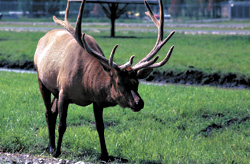It turns out that elk are pretty smart. In Ellensburg, just east of the Cascades, herds trample crops, tear up fences, smash lawns, and munch on expensive plants for much of the year, but as soon as the first rifle shots announce the beginning of hunting season, the animals are nowhere to be found. So says John Wisner of the Washington Department of Fish and Wildlife (WDFW). In Sequim, on the Olympic Peninsula, residents complained so much that authorities trapped some of the animals and moved them to the Nooksack reservation. End result: Some Nooksack residents now complain about elk damage.
“It happens all over the state,” says Wisner. The town of Forks, on the Peninsula, and the Boistfort Valley, in southwest Washington, are two other areas having elk trouble. In the valley, springtime flooding left the soggy ground extremely waterlogged. The fragile turf was no match for the elks’ heavy hooves, and now, Wisner says, the land is torn to shreds.
But the worst, the hot spot—the real free-for-all—is Ellensburg, where growth at Central Washington University has spurred development behind the school. Unfortunately, elk herds have used that area as a migration route for eons, Wisner says, and they’re not about to divert their path just because a bunch of houses have sprung up in the past decade.
In these cases, WDFW has authorized that some animals be removed. In the past, this involved trapping animals, harassing them with firecrackers (the elk soon grew wise), or euthanizing them. In the early ’90s, someone at WDFW figured out that ordinary hunters could be useful. So, after numerous complaints and biological field studies, the department authorized a special hunt to thin the herd.
When WDFW first founded the program, abuses ran rampant, Wisner says. The only requirements for participation were shooting proficiency, 12 hours of volunteer work, and a passing score on a test. More important, it was damn near impossible to get kicked out. Some people got suspended, Wisner says, but that took three big-game violations.
In December, Wisner saw a pair of hunters in the program “harvest” four elk from inside their truck, with the farthest elk some 700 yards away. That isn’t exactly illegal, but it is ethically wrong for two reasons. Someone who’s shooting from 550 to 700 yards “probably has a gun that costs more than their pickup,” Wisner says. It’s a bit of a slap in the face to old-school hunters, who may track an elk for hours before shooting it from 200 yards away. Also, from that distance, it’s difficult, if not impossible, to ensure that the bullet hits the animal’s neck—a guaranteed kill shot. A wound to the shoulder or rump—despite what the Big Buck Hunter arcade game would have us believe—is not a kill shot. If the hunter can’t find the animal, it will probably crawl off somewhere and die, perhaps hours or even days later.
Luckily, the hunters were solid marksmen; the animals dropped where they were shot. However, the hunters broke another set of rules when they drove their truck into an area closed to motor vehicles, unloaded an ATV, drove further into the closed area, tied the elk to the back of the four-wheeler, dragged the animals back to the truck, loaded all four elk, loaded the ATV on top of the elk, and prepared to leave. Wisner says he called 911, and an agent cited the men for keeping a loaded weapon in their truck and for driving on a closed road. The two men kept the elk and headed toward Spokane.
Incidents like these showed Wisner that the program needed major reworking. He closed it down for nine months and, in January, began to take applications again. Participants are now to be called Master Hunters, and Wisner hopes there are enough requirements in place to keep the bubbas out.
These hunters will be obliged to sign a code of ethics, in which they “pledge to act in accordance with the highest ethical standards and to display proper respect for game, landowners, other hunters and the public.” Among experienced hunters, that generally means: close ranchers’ gates, report any wrongdoing, and, above all, find and eat the animals you shoot. Don’t just take the rack and the pelt and leave the carcass to the vultures.
There is also a written examination on which potential Master Hunters must score at least 80 percent. The test examines knowledge of hunting regulations as well as hunting ethics. Master Hunters must also attend Crime Observation Reporting Training (CORT, as it’s known). A bit like Neighborhood Watch, CORT teaches and encourages hunters and other outdoor enthusiasts to report wildlife crimes in a nonconfrontational manner—a good idea in a sport where everybody has a gun.
Master Hunters are also required to donate 20 to 40 hours of time to wildlife management projects, such as shooing elk off privately owned land, working at a hatchery, repairing fences, teaching basic hunter-education courses, or a slew of other options. The thought behind the volunteer requirement is that only those who have a genuine interest in conservation will put up with it.
Lastly, there is a background check. This has some people pissed. One man claimed on Wisner’s blog that WDFW was selling him down the river. The poster, calling himself “shaydo,” wrote that he “applauds the ethics improvement,” but the background check, in his opinion, goes too far. “While disqualification due to wildlife-based violations is proper, there is no reason to include felony convictions in all areas as reason to deny,” shaydo wrote. (Shaydo claims he was wrongfully convicted of domestic violence.)
Around May, the Department of Fish and Wildlife comes up with the rules and regulations for that year’s hunting season. The regulations list such stipulations as whether cows or bulls may be taken and which parts of the state are open for hunting. If the department decides that males may be hunted, it may decree a certain antler size—say, spikes only (one point on each side), two points on each side, three points, or more. Generally, the larger the antlers, the older the bull. The season generally begins in late October and lasts nine to 14 days, and each hunter is usually allowed to kill one animal per season. Master Hunters, on the other hand, are eligible to participate in special hunts and may be able to take more than one.
For those wishing to participate in the program, an orientation meeting will be held March 22 from 1 to 4 p.m. in Room 172 of the Natural Resources Building, 1111 Washington St., Olympia. The Washington Department of Fish and Wildlife is accepting applications through April 16.






